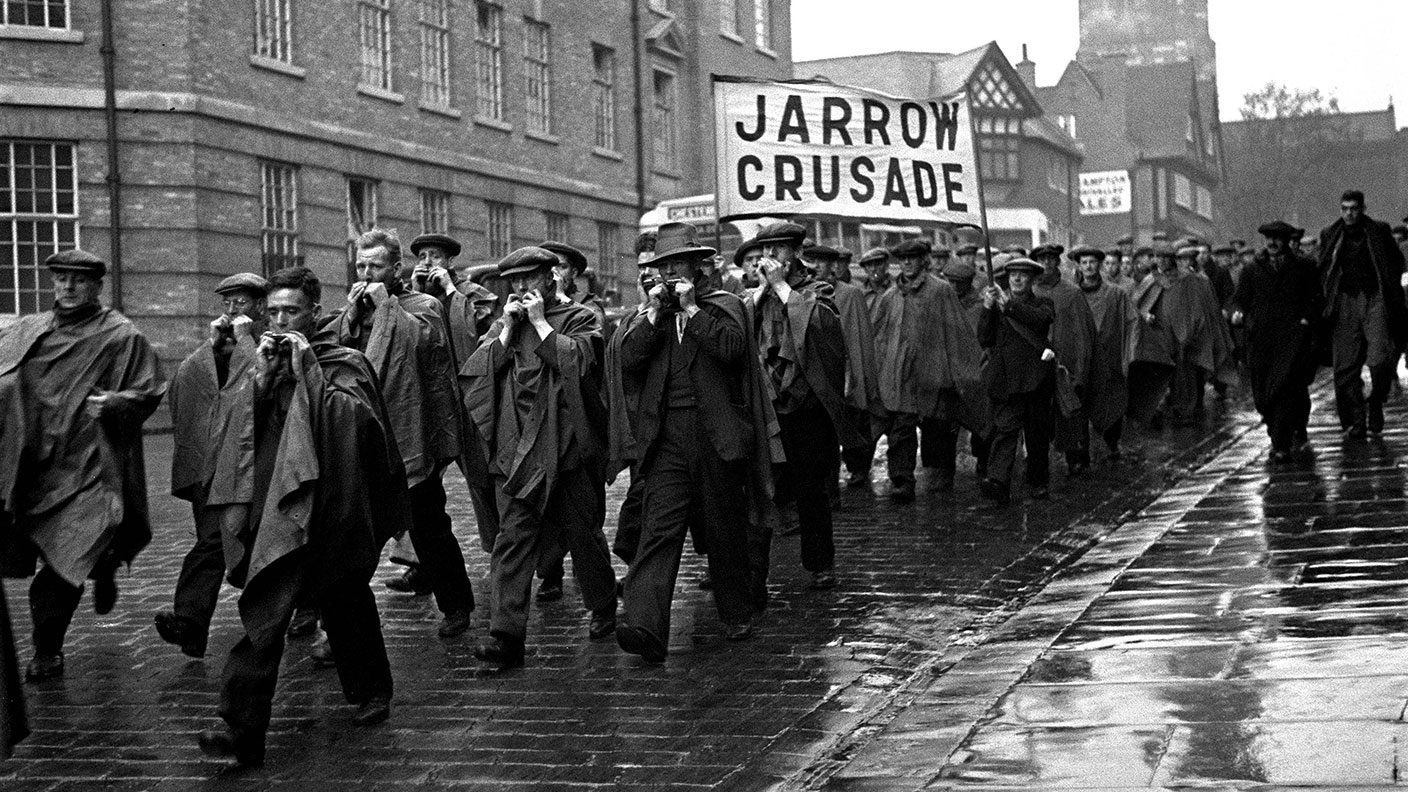5 October 1936: the Jarrow Crusade sets off for London
On this day in 1936, 200 men set off on the Jarrow Crusade to march the 300 miles from County Durham to London to demand the government take action on unemployment.

For over a hundred years from the middle of the 19th century, Jarrow, in County Durham, had been a thriving shipbuilding town. By the 1930s, Palmers Shipbuilding and Iron Company employed 80% of the town's workforce.
Then the Great Depression hit, and Palmers closed. Unemployment soared to 70%. And with unemployment benefit lasting just 26 weeks, things soon started looking grim. The people of the town wanted the government to do something – many wanted them to build a steelworks to provide employment. And so on 20 July 1936, Jarrow Borough Council decided to present a petition to Parliament demanding that "His Majesty's Government and this honourable House should realise the urgent need that work should be provided for the town without further delay."
The petition was circulated and received 11,000 signatures. A "crusade" – a march the length of the country to London – would be staged to bring the petition, carried in an oak box, to the government.
Subscribe to MoneyWeek
Subscribe to MoneyWeek today and get your first six magazine issues absolutely FREE

Sign up to Money Morning
Don't miss the latest investment and personal finances news, market analysis, plus money-saving tips with our free twice-daily newsletter
Don't miss the latest investment and personal finances news, market analysis, plus money-saving tips with our free twice-daily newsletter
Some 200 physically fit men (women were not invited to march) were selected from the local population and checked to ensure they could endure the 300-mile walk to London. And on this day in 1936, they set off, a mouth organ band leading the way.
It wasn't the first march of its kind. The National Unemployed Workers' Movement had organised “hunger marches”, including one of 2,000 people in 1932, plus others in 1934 and 1936. But there was a strong scent of Bolshevism about those marches which meant they weren't widely supported. For this one, however, Ellen Wilkinson, Jarrow's Labour MP, threw her weight behind the cause, despite the misgivings of her national party. And her presence ensured huge publicity.
As they wound their way south, the petition was added to, and the marchers received hospitality along the way. They finally reached London on 31 October. And Ellen Wilkinson presented the petition in Parliament on 4 November. But, rather than the petition, it was the coming of war that brought industry back to the town of Jarrow. The shipyards were reopened in 1938, and in 1939, the Consett Iron Company started a steelworks.
Get the latest financial news, insights and expert analysis from our award-winning MoneyWeek team, to help you understand what really matters when it comes to your finances.
Ben studied modern languages at London University's Queen Mary College. After dabbling unhappily in local government finance for a while, he went to work for The Scotsman newspaper in Edinburgh. The launch of the paper's website, scotsman.com, in the early years of the dotcom craze, saw Ben move online to manage the Business and Motors channels before becoming deputy editor with responsibility for all aspects of online production for The Scotsman, Scotland on Sunday and the Edinburgh Evening News websites, along with the papers' Edinburgh Festivals website.
Ben joined MoneyWeek as website editor in 2008, just as the Great Financial Crisis was brewing. He has written extensively for the website and magazine, with a particular emphasis on alternative finance and fintech, including blockchain and bitcoin.
As an early adopter of bitcoin, Ben bought when the price was under $200, but went on to spend it all on foolish fripperies.
-
 ‘Inheritance tax insurance’ enquiries are soaring – but is it worth it?
‘Inheritance tax insurance’ enquiries are soaring – but is it worth it?Premiums for whole of life insurance can run to £5,000 a month to cover a £300,000 inheritance tax bill, with policies costing more the older you take them out.
-
 MPs warn over Lifetime ISAs which could leave savers out of pocket
MPs warn over Lifetime ISAs which could leave savers out of pocketThe Treasury Committee has highlighted confusion around the Lifetime ISA withdrawal charge, which risks consumers losing “a significant part of their savings”
-
 31 August 1957: the Federation of Malaya declares independence from the UK
31 August 1957: the Federation of Malaya declares independence from the UKFeatures On this day in 1957, after ten years of preparation, the Federation of Malaya became an independent nation.
-
 13 April 1960: the first satellite navigation system is launched
13 April 1960: the first satellite navigation system is launchedFeatures On this day in 1960, Nasa sent the Transit 1B satellite into orbit to provide positioning for the US Navy’s fleet of Polaris ballistic missile submarines.
-
 9 April 1838: National Gallery opens in Trafalgar Square
9 April 1838: National Gallery opens in Trafalgar SquareFeatures On this day in 1838, William Wilkins’ new National Gallery building in Trafalgar Square opened to the public.
-
3 March 1962: British Antarctic Territory is created
Features On this day in 1962, Britain formed the British Antarctic Territory administered from the Falkland Islands.
-
10 March 2000: the dotcom bubble peaks
Features Tech mania fanned by the dawning of the internet age inflated the dotcom bubble to maximum extent, on this day in 2000.
-
9 March 1776: Adam Smith publishes 'The Wealth of Nations'
Features On this day in 1776, Adam Smith, the “father of modern economics”, published his hugely influential book The Wealth of Nations.
-
 8 March 1817: the New York Stock Exchange is formed
8 March 1817: the New York Stock Exchange is formedFeatures On this day in 1817, a group of brokers moved out of a New York coffee house to form what would become the biggest stock exchange in the world.
-
7 March 1969: Queen Elizabeth II officially opens the Victoria Line
Features On this day in 1969, Queen Elizabeth II took only her second trip on the tube to officially open the underground’s newest line – the Victoria Line.

